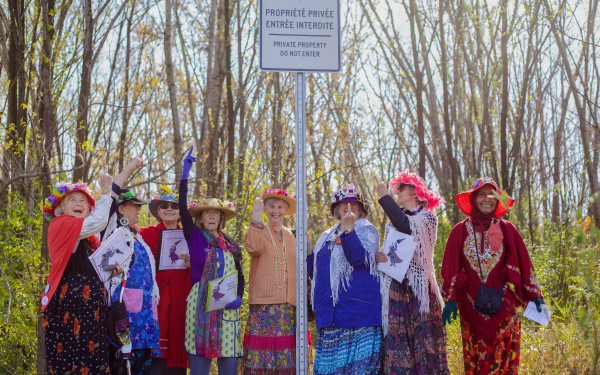Camp Line 9: Activists Decry Oil Exploration on Spill Site
Environmental, Anti-Colonial Activists Come Together
At first glance, Camp Line 9 resembles a summer camp in the 1960s. Colourful tents are spread out beneath the bones of an abandoned greenhouse in rows a dozen long, and the strumming of a guitar seems ever-present in the background.
The camp was formed by many of the same people who attended the “Peoples’ Walk for Mother Earth,” a march this summer which protested tar sands and pipelines spanning from Cacouna, near Rivière-du-Loup, to Kanehsatake, northwest of Montreal.
“It was an amazing way to create […] a stronger force to show that there are many people against these projects and that we have to keep on fighting,” organizer Alyssa Symons-Bélanger said.
Tree nursery owner Claire Durocher invited activists to her land in Saint-André-d’Argenteuil, where the pipeline Line 9, buried beneath her soil four decades ago, leaked last year and ruined her harvest.
When Durocher went to court to claim compensation for her lost crops, “Enbridge [Inc.] tried to blame it on her, saying that the oil came from her tractors or that it wasn’t really a spill,” Symons-Bélanger told The Link.
The camp, which includes a makeshift kitchen and communal library, was set up Sept. 20 and is set to run until Oct. 4. Three vegetarian meals a day are provided, and workshops on a range of topics related to environmental and anti-colonial activism were held.
Blockading 101
Because Line 9 is several decades old, Enbridge periodically runs “integrity digs” to check the valves on the pipeline and make repairs if necessary. Some activists disrupt Enbridge’s activities by halting work on the digs with blockades.
Two activists from an anarchist group in Guelph, Ont., held a workshop on the 10 basic steps of setting up a pipeline blockade. Wolf Chrapko and Sarah Scanlon helped organize “Dam Line 9” and “Swamp Line 9,” two such actions held in Ontario this summer, which temporarily stopped work on the pipeline.
They opened the workshop by highlighting the importance of acknowledging traditional indigenous ownership of the land that many pipelines run through and seeking acceptance from those communities.
Scanlon spoke of the necessity of obtaining approval from indigenous communities when organizing a blockade on their land. She emphasized the importance of going further in discussion than a simple last-minute consultation.
“You need to be building these relationships [with indigenous communities] constantly, and not in reaction to not wanting to feel white guilt,” she continued.
Scanlon told an anecdote of getting the support of an indigenous group for a three-day blockade, but losing it on the second day.
“If they withdraw their support, you have to be prepared to pack up and leave,” she said.
“Police brutality is real, and going through pain compliance techniques when no one can see you isn’t fun,” -Wolf Chrapko
Non-native neighbors were also listed as important allies by Scanlon, who suggested handing out flyers that explain what the blockade aims to do, and even handing out cookies.
“If they say we can stay there, it takes longer for the police to kick us off.”
The final step was planning exit strategies. The activists stressed the importance of having multiple plans in mind in case of emergencies.
Chrapko explained that people who were okay with getting arrested at the blockade should plan together, and that those who intended to leave before police intervention should avoid knowing those plans.
She specified that people choosing to be “locked down”—meaning locked to something on the site—should remain visible to others “because police brutality is real, and going through pain compliance techniques when no one can see you isn’t fun.”
Indigenous Rights Panel
Walter David, a member of Kanehsatake First Nation, and Vanessa Gray, an Anishinabe-kwe community organizer, sat on a bench to speak about environmental racism to attentive campers spread out on the ground. Environmental racism is the placement of polluting facilities near low-income minority communities.
Gray began the panel by drawing a comparison between the living conditions in her indigenous community and those in wealthier non-indigenous areas.
“Many of the people that work in the chemical refineries that I live right next door to, they live in the north end […] where the nicer houses are, where they don’t have to be worried about spills and releases, the way the indigenous people of our area do.”
Gray explained that she, like many indigenous children in the community, had suffered from asthma as a child due to the toxic releases from the chemical refinery close by. She contrasted her own experience with that of the ruling class.
“I don’t imagine [Stephen Harper] would be okay with his kids suffering the same way as many of the indigenous kids do.
“It’s just a difference [of] class and race that creates this issue of industrial genocide in my back yard and not many of yours,” she told the crowd.
Correction: A previous version of this article stated that the Peoples’ March for Mother Earth took place in Quebec City. In fact, it went from Cacouna to Kanehsatake. The article also referred to the camp as “Camp 9” instead of “Camp Line 9.” The Link regrets the errors.

2_900_600_90.jpg)
5_900_600_90.jpg)
6_900_600_90.jpg)
3_900_600_90.jpg)
4_900_600_90.jpg)
_600_832_s.png)


2_600_375_90_s_c1.jpg)

_600_375_90_s_c1.jpg)